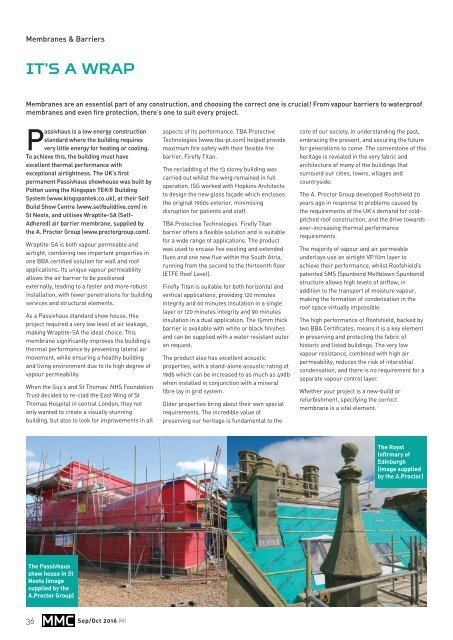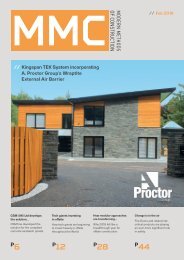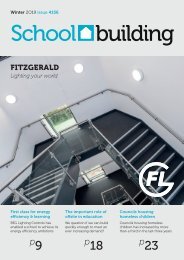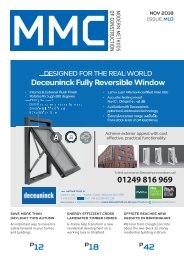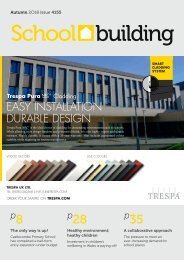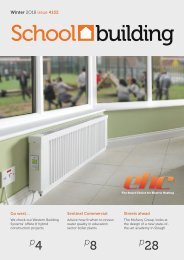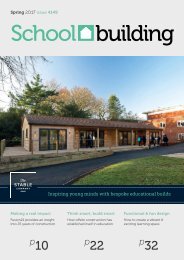Create successful ePaper yourself
Turn your PDF publications into a flip-book with our unique Google optimized e-Paper software.
Membranes & Barriers<br />
It’s a wrap<br />
Membranes are an essential part of any construction, and choosing the correct one is crucial! From vapour barriers to waterproof<br />
membranes and even fire protection, there’s one to suit every project.<br />
Passivhaus is a low energy construction<br />
standard where the building requires<br />
very little energy for heating or cooling.<br />
To achieve this, the building must have<br />
excellent thermal performance with<br />
exceptional airtightness. The UK’s first<br />
permanent Passivhaus showhouse was built by<br />
Potton using the Kingspan TEK® Building<br />
System (www.kingspantek.co.uk), at their Self<br />
Build Show Centre (www.selfbuildlive.com) in<br />
St Neots, and utilises Wraptite-SA (Self-<br />
Adhered) air barrier membrane, supplied by<br />
the A. Proctor Group (www.proctorgroup.com).<br />
Wraptite-SA is both vapour permeable and<br />
airtight, combining two important properties in<br />
one BBA certified solution for wall and roof<br />
applications. Its unique vapour permeability<br />
allows the air barrier to be positioned<br />
externally, leading to a faster and more robust<br />
installation, with fewer penetrations for building<br />
services and structural elements.<br />
As a Passivhaus standard show house, this<br />
project required a very low level of air leakage,<br />
making Wraptite-SA the ideal choice. This<br />
membrane significantly improves the building’s<br />
thermal performance by preventing lateral air<br />
movement, while ensuring a healthy building<br />
and living environment due to its high degree of<br />
vapour permeability.<br />
When the Guy’s and St Thomas’ NHS Foundation<br />
Trust decided to re-clad the East Wing of St<br />
Thomas Hospital in central London, they not<br />
only wanted to create a visually stunning<br />
building, but also to look for improvements in all<br />
aspects of its performance. TBA Protective<br />
Technologies (www.tba-pt.com) helped provide<br />
maximum fire safety with their flexible fire<br />
barrier, Firefly Titan.<br />
The recladding of the 13 storey building was<br />
carried out whilst the wing remained in full<br />
operation. ISG worked with Hopkins Architects<br />
to design the new glass façade which encloses<br />
the original 1960s exterior, minimising<br />
disruption for patients and staff.<br />
TBA Protective Technologies’ Firefly Titan<br />
barrier offers a flexible solution and is suitable<br />
for a wide range of applications. The product<br />
was used to encase five existing and extended<br />
flues and one new flue within the South Atria,<br />
running from the second to the thirteenth floor<br />
(ETFE Roof Level).<br />
Firefly Titan is suitable for both horizontal and<br />
vertical applications, providing 120 minutes<br />
integrity and 60 minutes insulation in a single<br />
layer or 120 minutes integrity and 90 minutes<br />
insulation in a dual application. The 15mm thick<br />
barrier is available with white or black finishes<br />
and can be supplied with a water resistant outer<br />
on request.<br />
The product also has excellent acoustic<br />
properties, with a stand-alone acoustic rating of<br />
19db which can be increased to as much as 49db<br />
when installed in conjunction with a mineral<br />
fibre lay in grid system.<br />
Older properties bring about their own special<br />
requirements. The incredible value of<br />
preserving our heritage is fundamental to the<br />
core of our society, in understanding the past,<br />
embracing the present, and securing the future<br />
for generations to come. The cornerstone of this<br />
heritage is revealed in the very fabric and<br />
architecture of many of the buildings that<br />
surround our cities, towns, villages and<br />
countryside.<br />
The A. Proctor Group developed Roofshield 20<br />
years ago in response to problems caused by<br />
the requirements of the UK’s demand for coldpitched<br />
roof construction, and the drive towards<br />
ever-increasing thermal performance<br />
requirements.<br />
The majority of vapour and air permeable<br />
underlays use an airtight VP film layer to<br />
achieve their performance, whilst Roofshield’s<br />
patented SMS (Spunbond Meltblown Spunbond)<br />
structure allows high levels of airflow, in<br />
addition to the transport of moisture vapour,<br />
making the formation of condensation in the<br />
roof space virtually impossible.<br />
The high performance of Roofshield, backed by<br />
two BBA Certificates, means it is a key element<br />
in preserving and protecting the fabric of<br />
historic and listed buildings. The very low<br />
vapour resistance, combined with high air<br />
permeability, reduces the risk of interstitial<br />
condensation, and there is no requirement for a<br />
separate vapour control layer.<br />
Whether your project is a new-build or<br />
refurbishment, specifying the correct<br />
membrane is a vital element.<br />
The Royal<br />
Infirmary of<br />
Edinburgh<br />
(image supplied<br />
by the A.Proctor)<br />
The Passivhaus<br />
show house in St<br />
Neots (image<br />
supplied by the<br />
A.Proctor Group)<br />
36 <strong>MMC</strong><br />
Sep/Oct 2016 MI


